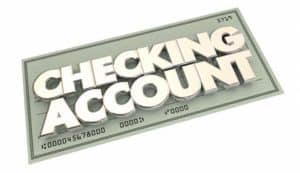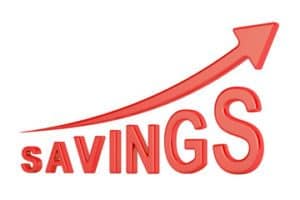
Checking and Savings account are the most common banking accounts. While both hold your money securely, they come with a fairly long list of differences.
It is important to understand the differences so you can make the most out of your money. Keep reading to find the right account for you.
 |
 |
Checking vs. Savings
| Checking | Savings | |
| General use | Spending | Saving |
| Withdrawal limits | None | Six per month (excluding in-person and ATM withdrawals) |
| Does it pay interest? | Sometimes, minimal. | Yes |
| Common fees |
Some checking accounts don’t have all these fees. |
You can find some savings accounts that don’t have these fees. |
| Minimum balance requirements | Varies | Varies |
| Typical Features |
|
|
Checking Accounts Are for Spending
Checking accounts are meant to keep the money you plan to spend. However, they generally don’t offer interest on your account balance. Thus it is not recommended that you keep large sums of money in it.
Additionally, checking accounts offer debit cards and online bill pay to assist you. This makes it more convenient for online payments, electronic billing, and in person purchases.
Save for the Future
The key difference is that Savings accounts will earn interest on your account balance. You can earn additional funds simply by not touching your money.
This is ideal for saving for a future goal such as a vacation or for gifts around the holidays. Furthermore, health savings accounts are a solution when you have excessive health costs.
Checking Accounts
 Checking Accounts are designed for frequent transactions, and you can use the money in several different ways.
Checking Accounts are designed for frequent transactions, and you can use the money in several different ways.
- Electronic Payments: Banks and Credit Unions nowadays all offer a sophisticated online platform to set-up automatic payments on bills, etc. This is a convenient solution for making recurring payments on time.
- Debit Cards: Checking accounts all offer a debit card to help you with in-person or online purchases. Expenses are “debited” or deducted from your account balance.
- ATM Withdrawals: You can also use this debit card are ATM’s to access you account balance and withdrawal cash. This is important for some places still only accept cash payments.
- Checks: While electronic payments are becoming increasingly popular, checking accounts generally offer a free box of paper checks.
The majority of checking accounts don’t pay out any interest. However, if you keep a large amount of cash in your checking account, it may be in your best interest to find an interest paying account.
Statistically, the average interest checking account earns 0.05% APY, while the average savings account earns 0.09% APY.
Generally, there are strict requirements that have to be met in order to earn the interest on your checking.
- Based off our experience, certain interest bearing checking accounts require minimum transactions to earn interest. This takes the value out of the account entirely. It is most comparable to a credit card that earns you cash rewards when you spend.
If your main goal is to accumulate interest, then checking accounts are not the way to go. It’s always nice to earn back a little bit of change, but even the checking accounts that do offer interest usually offer an incredibly low amount.
There are two ways to bank without paying monthly charges.
- Find a Free Checking Account: The best way to make the most out of your account is by not having to pay service charges. We recommend you find a free checking account to avoid these excessive fees.
- Free Waivers: Alternatively, you may find a checking account with the right features for your individual needs. More premier checking accounts generally charge higher service charges, but you can also waive them by meeting their requirements. Before signing up for a checking account it is important to know about the hidden fees.
- Overdraft Charges: These are transaction fees that occur when you spend more than you have in your account. The bank may lend you money that will allow you to spend even if you run out of cash. You’ll have to pay them back along with the overdraft charge.
- Maintenance Charges: Flat dollar fee that that will be deducted from your account every month. Try to avoid accounts that have this fee.
- Additional Fees: There are always different fees that can stack up. For example you might have to pay a fee for using an ATM. However, some accounts such as the Chase Premier Checking waive foreign ATM fees.
Savings Accounts
 Savings accounts often allow you to earn interest on the funds in your account, and opening one can be a good step toward building wealth. Here are some Savings account features.
Savings accounts often allow you to earn interest on the funds in your account, and opening one can be a good step toward building wealth. Here are some Savings account features.
- Interest: The key difference is that Savings accounts guarantee an interest rate. While the interest rate isn’t always high, it is still impactful. Banks and Credit Union’s offer a variety of savings accounts to meet your individual need. Sometimes you can even offer a savings account for a child or dependent.
- Membership: Credit Union are localized financial entities that offer similar account services as large banks. Credit Union’s are also not for profit and give all their earnings back to their members. They have membership requirements, such as you having to live in a certain county, that once you meet you are eligible to join. Membership is formally established when you open a Share Savings account.
Remember you can only withdraw from a savings account 6 times per month. However, there are plenty of ways to use the money in your savings when you need it.
- Cash Withdrawals: If your bank gives you an ATM card, you can access your savings from any ATM. You can also go to your bank local branch and request a withdrawal from your savings account.
- Transfer to Checking: You can simply transfer your savings to your checking whenever you need to. If you are within the same bank, then this process is nearly instant. Going from bank to bank usually takes a little bit longer.
- Checks: Banks can print checks that are payable to you. Cash in these checks to easily withdraw cash from your savings. There is no limit to how many times you can cash in a check payable to yourself.
In general savings accounts are much cheaper than checking. There is usually no cost for the account, but miscellaneous fees such as ATM fees can hurt. Make sure you check with your bank or Credit Union to get a better understanding of your savings account.
Choosing the Right Account
Now that you have a better understanding of the uses of both accounts we hope that you can make the most out of your money.
Online Banks are becoming increasingly popular. The internet has made it possible for consumers to access their accounts through online or mobile banking.
We recommend you combine the convenience of both checking and savings accounts. You can open a checking account at one bank and have a savings account at another to start saving for a vacation, present, or health expense.
Conclusion
When it comes down to opening a checking or savings account to store your money, make sure you understand the features and functions of each.
This will help you determine what best fits your needs. Feel free to comment below and let us know about a topic you would like us to cover. Also, don’t forget to checkout our complete list of Bank Deals for all your banking needs!


